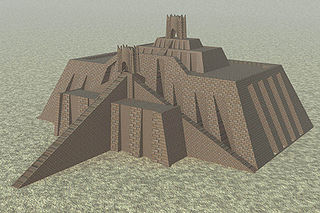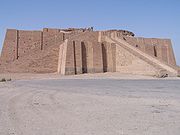
Great Ziggurat of Ur
Encyclopedia


Ziggurat
Ziggurats were massive structures built in the ancient Mesopotamian valley and western Iranian plateau, having the form of a terraced step pyramid of successively receding stories or levels.Notable ziggurats include the Great Ziggurat of Ur near Nasiriyah, Iraq; the Ziggurat of Aqar Quf near...
in what was the city of Ur
Ur
Ur was an important city-state in ancient Sumer located at the site of modern Tell el-Muqayyar in Iraq's Dhi Qar Governorate...
near Nasiriyah
Nasiriyah
Nasiriyah is a city in Iraq. It is on the Euphrates about 225 miles southeast of Baghdad, near the ruins of the ancient city of Ur. It is the capital of the province of Dhi Qar...
, in present-day Dhi Qar Province, Iraq
Iraq
Iraq ; officially the Republic of Iraq is a country in Western Asia spanning most of the northwestern end of the Zagros mountain range, the eastern part of the Syrian Desert and the northern part of the Arabian Desert....
. The structure was built during the Early Bronze Age (21st century BC), but had crumbled to ruins by the 6th century BC of the Neo-Babylonian period when it was restored by King Nabonidus
Nabonidus
Nabonidus was the last king of the Neo-Babylonian Empire, reigning from 556-539 BCE.-Historiography on Nabonidus:...
.
Its remains were excavated in the 1920s and 1930s by Sir Leonard Woolley
Leonard Woolley
Sir Charles Leonard Woolley was a British archaeologist best known for his excavations at Ur in Mesopotamia...
. Under Saddam Hussein
Saddam Hussein
Saddam Hussein Abd al-Majid al-Tikriti was the fifth President of Iraq, serving in this capacity from 16 July 1979 until 9 April 2003...
in the 1980s, they were encased by a partial reconstruction of the façade and the monumental staircase. The ziggurat of Ur is the best-preserved of those known from Iran and Iraq, besides the ziggurat of Dur Untash (Chogha Zanbil). It is one of three well preserved structures of the Neo-Sumerian city of Ur, along with the Royal Mausolea and the Palace of Ur-Nammu (the E-hursag).
Sumerian ziggurat
The ziggurat was built by King Ur-NammuUr-Nammu
Ur-Nammu founded the Sumerian 3rd dynasty of Ur, in southern Mesopotamia, following several centuries of Akkadian and Gutian rule...
who dedicated the great ziggurat of Ur in honour of Nanna/Sîn, in approximately the 21st century BC (short chronology) during the Third Dynasty of Ur
Third Dynasty of Ur
The Third Dynasty of Ur, also known as the Neo-Sumerian Empire or the Ur III Empire refers simultaneously to a 21st to 20th century BC Sumerian ruling dynasty based in the city of Ur and a short-lived territorial-political state that some historians regard as a nascent empire...
. The massive step pyramid
Step pyramid
Step pyramids are structures which characterized several cultures throughout history, in several locations throughout the world. These pyramids typically are large and made of several layers of stone...
measured 210 feet (64m) in length, 150 feet (46m) in width and over 100 feet (30m) in height. The height is speculative, as only the foundations of the Sumerian ziggurat have survived.
The ziggurat was a piece in a temple complex that served as an administrative center for the city, and which was a shrine of the moon god
Lunar deity
In mythology, a lunar deity is a god or goddess associated with or symbolizing the moon. These deities can have a variety of functions and traditions depending upon the culture, but they are often related to or an enemy of the solar deity. Even though they may be related, they are distinct from the...
Nanna
Sin (mythology)
Sin or Nanna was the god of the moon in Mesopotamian mythology. Nanna is a Sumerian deity, the son of Enlil and Ninlil, and became identified with Semitic Sin. The two chief seats of Nanna's/Sin's worship were Ur in the south of Mesopotamia and Harran in the north.- Name :The original meaning of...
, the patron deity of Ur
Ur
Ur was an important city-state in ancient Sumer located at the site of modern Tell el-Muqayyar in Iraq's Dhi Qar Governorate...
.
The construction of the ziggurat
Ziggurat
Ziggurats were massive structures built in the ancient Mesopotamian valley and western Iranian plateau, having the form of a terraced step pyramid of successively receding stories or levels.Notable ziggurats include the Great Ziggurat of Ur near Nasiriyah, Iraq; the Ziggurat of Aqar Quf near...
was finished in the 21st century BC by King Shulgi
Shulgi
Shulgi of Urim was the second king of the "Sumerian Renaissance". He reigned for 48 years, dated to 2029 BCE–1982 BCE...
, who, in order to win the allegiance of cities, proclaimed himself a god. During his 48-year reign, the city of Ur grew to be the capital of a state controlling much of Mesopotamia
Mesopotamia
Mesopotamia is a toponym for the area of the Tigris–Euphrates river system, largely corresponding to modern-day Iraq, northeastern Syria, southeastern Turkey and southwestern Iran.Widely considered to be the cradle of civilization, Bronze Age Mesopotamia included Sumer and the...
.
Neo-Babylonian restoration
King NabonidusNabonidus
Nabonidus was the last king of the Neo-Babylonian Empire, reigning from 556-539 BCE.-Historiography on Nabonidus:...
, the last king of the Neo-Babylonian Empire
Neo-Babylonian Empire
The Neo-Babylonian Empire or Second Babylonian Empire was a period of Mesopotamian history which began in 626 BC and ended in 539 BC. During the preceding three centuries, Babylonia had been ruled by their fellow Akkadian speakers and northern neighbours, Assyria. Throughout that time Babylonia...
in the 6th century BC, after "finding little left but the last stage and nothing to guide him as to the monument's original appearance", had it restored in seven stages rather than three.
Excavation and preservation
The remains of the ziggurat were first described by William Kennett Loftus in the early 19th century.The first excavations at the site were conducted by John George Taylor (mistakenly credited as "J. E. Taylor") in the 1850s, leading to the identification of the site as Ur.
After World War I
World War I
World War I , which was predominantly called the World War or the Great War from its occurrence until 1939, and the First World War or World War I thereafter, was a major war centred in Europe that began on 28 July 1914 and lasted until 11 November 1918...
, preliminary excavations were performed by Reginald Campbell Thomson and Henry Hall
Henry Hall (Egyptologist)
Dr Henry Reginald Holland Hall MBE, FBA, FSA was an English Egyptologist and historian. In life, he was normally referred to as Harry Reginald Hall.-Early life:...
. The site was extensively excavated in the 1920s by Sir Leonard Woolley
Leonard Woolley
Sir Charles Leonard Woolley was a British archaeologist best known for his excavations at Ur in Mesopotamia...
by appointment of the University Museum of the University of Pennsylvania and the British Museum in the period of 1922 to 1934.
The remains of the ziggurat consist of a three-layered solid mass of mud brick faced with burnt bricks set in bitumen. The lowest layer corresponds to the original construction of Ur-Nammu, while the two upper layers are part of the Neo-Babylonian restorations. The façade of the lowest level and the monumental staircase were rebuilt under the orders of Saddam Hussein
Saddam Hussein
Saddam Hussein Abd al-Majid al-Tikriti was the fifth President of Iraq, serving in this capacity from 16 July 1979 until 9 April 2003...
.
The ziggurat was damaged in the First Gulf War in 1991 by small arms fire and the structure was shaken by explosions. Four bomb craters can be seen nearby and the walls of the ziggurat are marred by over 400 bullet holes.
The site is currently under the supervision of Curator Dief Mohssein Naiif al-Gizzy.
See also
- Ali Air BaseAli Air BaseAli Air Base is a military airbase located near Nasiriyah, Iraq. It is also known as Tallil Air Base. At present, the base is being used by United States Armed Forces. It is called Camp Adder by the U.S. Army; the name "Ali Air Base" is used chiefly by the U.S...
- Ennigaldi-Nanna's museumEnnigaldi-Nanna's museumEnnigaldi-Nanna's museum is the first museum known to historians dating to circa 530 BCE.Casey, p. "Public Museum" Around 530 B.C.E. in Ur, an educational museum containing a collection of labeled antiquities was founded by Ennigaldi-Nanna the, daughter of Nabonidus, the last king of...
- SumerSumerSumer was a civilization and historical region in southern Mesopotamia, modern Iraq during the Chalcolithic and Early Bronze Age....
- Sumerian architecture
- Third Dynasty of UrThird Dynasty of UrThe Third Dynasty of Ur, also known as the Neo-Sumerian Empire or the Ur III Empire refers simultaneously to a 21st to 20th century BC Sumerian ruling dynasty based in the city of Ur and a short-lived territorial-political state that some historians regard as a nascent empire...
- ZigguratZigguratZiggurats were massive structures built in the ancient Mesopotamian valley and western Iranian plateau, having the form of a terraced step pyramid of successively receding stories or levels.Notable ziggurats include the Great Ziggurat of Ur near Nasiriyah, Iraq; the Ziggurat of Aqar Quf near...
- Ziggurat of Aqar Quf

